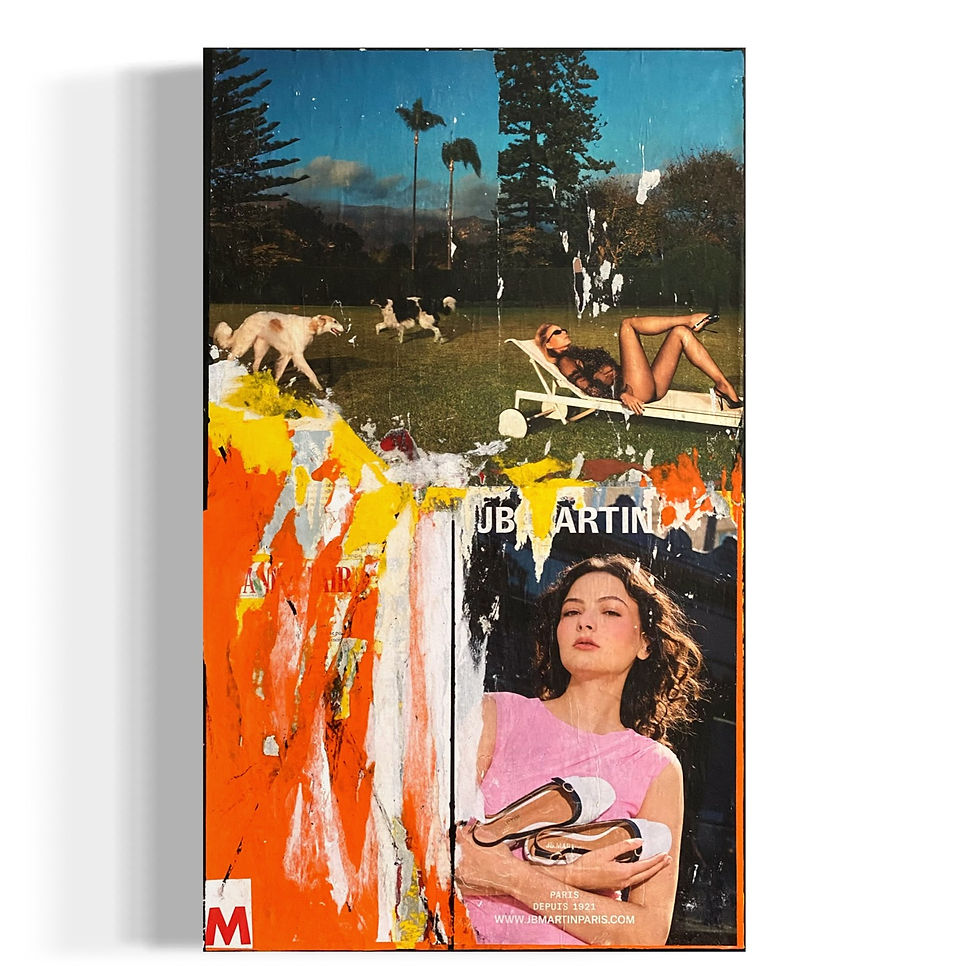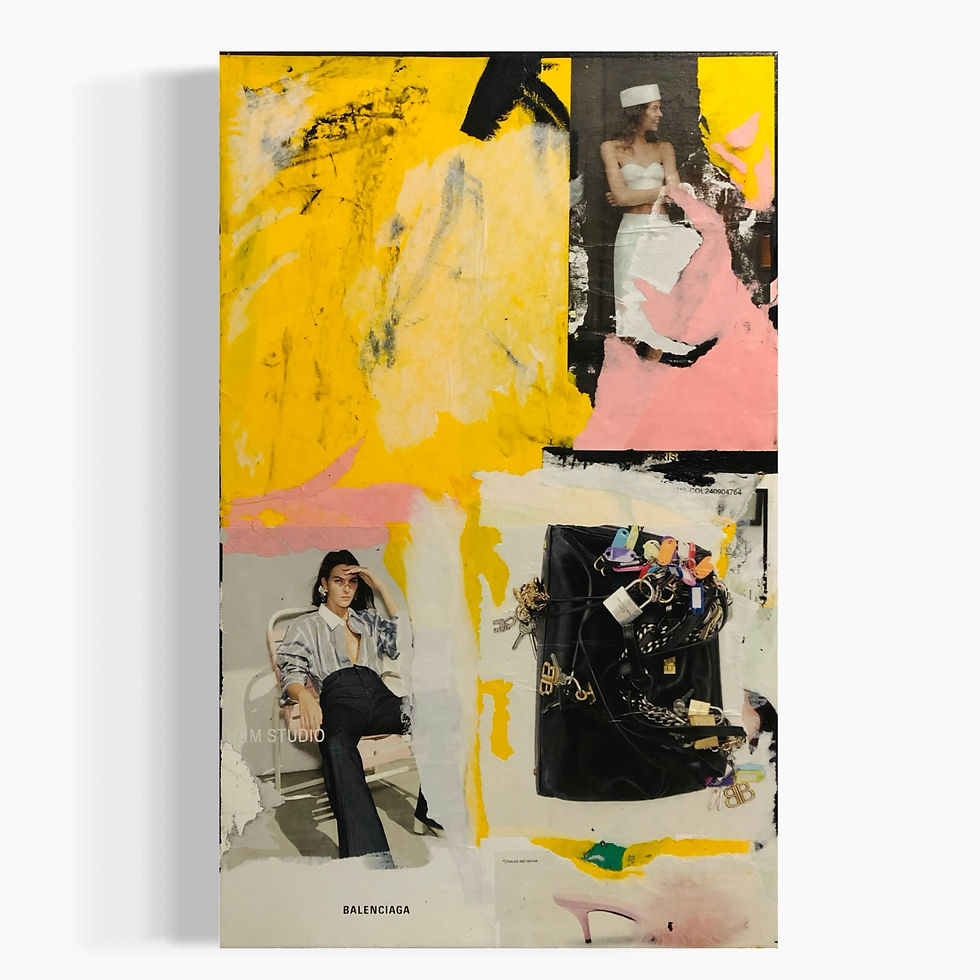Maxime Déria
- Anna Lilli Garai
- Aug 12
- 5 min read
Maxime Déria is a French self-taught artist working with collage and acrylic on paper and canvas. He draws from memories, romantic relationships, and everyday imagery found in magazines or discarded paper. His process is intuitive, often starting with a phrase or image that sparks something personal. The works come together through layering, cutting, painting, and reworking, sometimes covering previous versions to build new ones. In pieces like "Un jeu d’enfant," past and present blend in quiet, playful ways, holding both personal meaning and space for interpretation.

Q: Your paintings feel like torn pages from a diary. How do you decide which memories make it onto the canvas?
A: It often starts with an image, a phrase, or a detail found in a magazine or elsewhere that sparks something. I associate it with a memory—sometimes very vague, sometimes clearer. But most of the time, I don’t begin with a precise idea in mind. I never tell myself: “I need this specific image to talk about that particular memory.”
In truth, it’s more about something I see or feel in the moment—something that resonates with my memory. There’s often an element of chance. I rarely plan things in advance. I usually let myself be guided by whatever emerges. And once I’m immersed in the process of creating the work, I get carried away by it—by my mind and my memories—and connections begin to form, more or less complex, but always with a touch of humor.


Q: Collage plays a big role in your work. What draws you to torn paper as a way of telling a story?
A: I enjoy the richness it offers me. It allows me to play simultaneously with images, text, and colors that I reinterpret and reuse to give them a new story shaped by my own memories. I mainly use the French language—not only because it is my mother tongue, but also because it adds a sense of romance associated with how France is often perceived, including by myself. This adds a layer of authenticity to my work. I really enjoy playing with all these elements, and collage gives me the freedom to do so. There's also an element of unpredictability in the magazines I use, which I find particularly fascinating.




Q: You often blur the line between personal and collective memory. Is there a recent work where that tension felt especially present?
A: In the artwork Un jeu d’enfant, following a breakup, I covered the original piece with the result you see today, as a way to turn the page. There was a note she had written, which I had glued onto the canvas, now hidden beneath the new version.
Fragments of red from the previous version are still visible and blend with this new, much more joyful and colorful layer—a simple way for me to express that there are still good memories from those past moments, and that I have no difficulty living with those memories today. I convey this ease through the very title of the work, as the first version was important to reach the final result. I used this breakup as a subject of study through my painting.
Q: How do romantic relationships shape the rhythm or mood of a piece for you?
A: I enjoy telling stories about romantic relationships through my work, as this is an integral part of my creative process—a personal exploration of my own heterosexuality.
This desire to focus my work on the theme of gender emerged naturally, simply because I am drawn to magazines, often women’s magazines, for the richness of their fashion imagery, which predominantly features female figures.
It also comes from the fact that I don’t live in a place where I can easily find concert or movie posters to repurpose in my work. So, I adapted—and this has shaped, and continues to shape, my practice to this day. Through my artistic work, I have found a free space where I can express myself openly and continue to explore my own research. Because my work is closely tied to my love life and private world—hence the maintenance of a public diary—I have the freedom to be very creative, playing with references and double meanings to conceal while still revealing, and to blur the line between reality and fiction. This helps to further blur boundaries, keep the subject intimate, and offer the viewer the possibility to interpret the work as they wish. I do not impose a fixed vision or interpretation on any piece.
Q: Do you ever revisit the same memory in multiple works—or is each canvas a sealed moment?
A: Not all of my works are necessarily tied to a specific memory, but I do sometimes incorporate more or less subtle references from one painting to another.
It’s a simple way to play with memories, like little nods or winks. That said, generally, each painting is linked to a precise memory. Not systematically associating every work with a particular memory or encounter also leaves more room for ambiguity and freedom for the viewer, so as not to confine my work to the idea of a perpetual diary. For me, these paintings are also moments of freedom, even though the main subject remains the same and serves as the common thread running through my entire body of work.
Q: Has painting changed the way you remember? Or the way you forget?
A: Generally, I tend to maintain good relationships with people, so holding onto memories and bringing them to life on canvas for a while doesn’t bother me. My work is mostly joyful and optimistic about the future; I don’t paint when I’m feeling sad. Although some memories may be linked to breakups, which can be difficult moments, I am generally an optimistic person. Rather than locking myself in grief, I prefer to step back and remind myself that, on the contrary, it’s wonderful—because I can use what I feel and channel it positively into my creativity and work. I refuse to let it harm me, and I believe every moment holds creative potential, as long as you approach it with a sense of humor. So, I see my painting as part of a process of remembering, which I can then reuse to my advantage later on.


